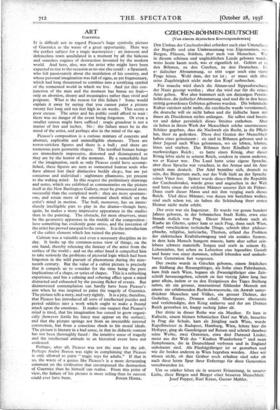ART
Guernica IT is difficult not to regard Picasso's huge symbolic picture of Guernica as the waste of a great opportunity. Here was the perfect subject for a tragic masterpiece : an innocent and defenceless town annihilated in a moment by all the hideohs and senseless engines of destruction invented by the modem world. And here, also, was the artist who might have been expected to rise to the occasion as no one else could : a Spaniard, who felt passionately about the mutilation of his country, and whose personal imagination was full of signs, as yet fragmentary, which had long threatened to combine into a terrifying symbol of the tormented world in which we live. And yet this con- junction of the man and the moment has borne no fruit— only an abortion, dreary and meaningless rather than vivid and poignant. What is the reason for this failure ? Some would explain it away by saying that you cannot paint a picture twenty feet long and ten feet high in six weeks. This seems a poor excuse. The artist and his public could afford to wait there was no danger of the event being forgotten. Or even a smaller canvas might have sufficed : tragic grandeur is not a matter of feet and inches. No : the failure must be in the mind of the artist, and perhaps also in the mind of the age.
Picasso's composition is a curious mixture of concrete and abstract, explicable and unintelligible elements. There are terror-stricken figures and there is a bull.; and there are numerous pure geometric shapes. The terrified human beings are immediately impressive, distorted and disintegrated as they are by the horror of the moment. By a remarkable feat of the imagination, such as only Picasso could have accomp- lished, these figures are seen as tormented human souls who have almost lost their distinctive bodily slupe, but are yet conscious and individual : nightmare phantoms, yet present to the waking mind. In this respect the preliminary drawings and notes, which are exhibited as commentaries on the picture itself at the New Burlington Gallery, must be pronounced more successful than the completed work : they are more spontane- ous, and retain more of the emotional shock which set the artist's mind in motion. The bull, moreover, has an imme- diately intelligible part to play in the drama—though here, again, he makes a more impressive appearance in the studies than in the painting. The obstacle, for most observers, must be the geometric apparatus in the middle of the composition : here something has evidently gone amiss, and the invention of the artist has proved unequal to the strain. It is the introduction of the cubist element which has ruined the picture.
Cubism was a valuable and even a necessary discipline in its day. It broke up the common-sense view of things, on the one hand, thereby releasing the fantasy of the artist from the surface of the world ; and on the_nther hand it _compelled him to take seriously the problems of pictorial logic which had been forgotten in the wild pursuit of phenomena during the nine- teenth century. But the value of a cubist picture is precisely that it compels us to consider for the time being the pure implications of a shape, or series of shapes. This is a refreshing experience, and has a calming and sobering effect upon a mind distracted and exhausted by the passing flicker of events. But disinterested contemplation can hardly have been Picasso's aim when he was inspired to paint the tragedy of Guernica. The picture tells a story, and very rightly. It is a pity, therefore, that Picasso has introduced all sorts of intellectual puzzles and period oddities into a work which ought to make a frontal attack upon the emotions. It makes one suspect that Picasso's mind is tired, that his imagination has ceased to grow organi- cally (however fertile his fancy may appear on the surface), and that the picture springs not froth an irresistible internal commotion, but from a conscious shock to his moral ideals. The picture is literary in a bad sense, in that its didactic content has not been thoroughly fused : the intuitive sense of tragedy and the intellectual attitude to an historical event have not coalesced.
Perhaps, after all, Picasso was not the man for the job. Perhaps Andre Breton was right in complaining thatPicasso is only allowed to paint " tragic toys for adults." If that is so, the waste of a genius like Picasso's is a more devastating comment on the civilisation that encompassed the destruction of Guernica than he himself can realise. From this point of view, the failure of his picture is more telling than its success
























































 Previous page
Previous page